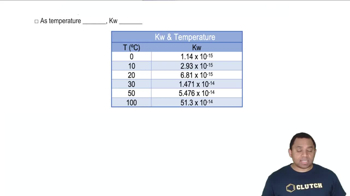Sulfur dioxide reacts with strontium oxide as follows: SO2(g) + SrO(g) → SrSO3(s) (a) Without using thermochemical data, predict whether ΔG° for this reaction is more negative or less negative than ΔH°.

Classify each of the following reactions as one of the four possible types summarized in Table 19.3: (i) spontaneous at all temperatures; (ii) not spontaneous at any temperature; (iii) spontaneous at low T but not spontaneous at high T; (iv) spontaneous at high T but not spontaneous at low T.
(c) N2F4(g) ⟶ 2 NF2(g) ΔH° = 85 kJ; ΔS° = 198 J/K
 Verified step by step guidance
Verified step by step guidance
Verified video answer for a similar problem:
Key Concepts
Gibbs Free Energy

Enthalpy and Entropy

Temperature Dependence of Spontaneity

Classify each of the following reactions as one of the four possible types summarized in Table 19.3: (i) spontanous at all temperatures; (ii) not spontaneous at any temperature; (iii) spontaneous at low T but not spontaneous at high T; (iv) spontaneous at high T but not spontaneous at low T.
(a) N2(g) + 3 F2(g) → 2 NF3(g) ΔH° = -249 kJ; ΔS° = -278 J/K
(b) N2(g) + 3 Cl2(g) → 2 NCl3(g) ΔH° = 460 kJ; ΔS° = -275 J/K
From the values given for ΔH° and ΔS°, calculate ΔG° for each of the following reactions at 298 K. If the reaction is not spontaneous under standard conditions at 298 K, at what temperature (if any) would the reaction become spontaneous?
a. 2 PbS(s) + 3 O2(g) → 2 PbO(s) + 2 SO2(g) ΔH° = −844 kJ; ΔS° = −165 J/K
b. 2 POCl3(g) → 2 PCl3(g) + O2(g) ΔH° = 572 kJ; ΔS° = 179 J/K
A certain constant-pressure reaction is barely nonspontaneous at 45 °C. The entropy change for the reaction is 72 J/K. Estimate ΔH.
